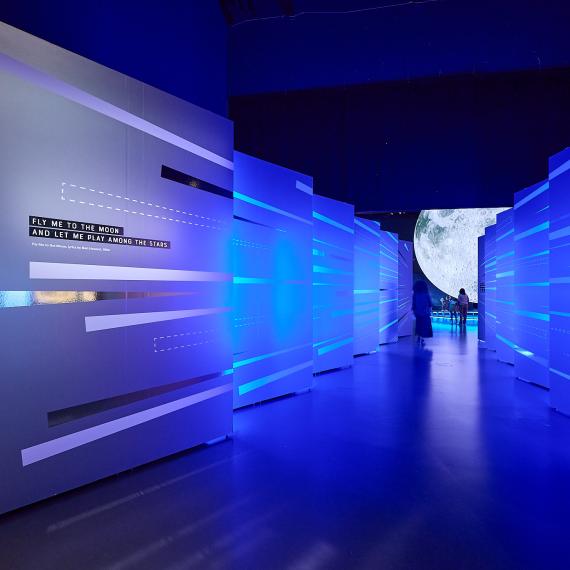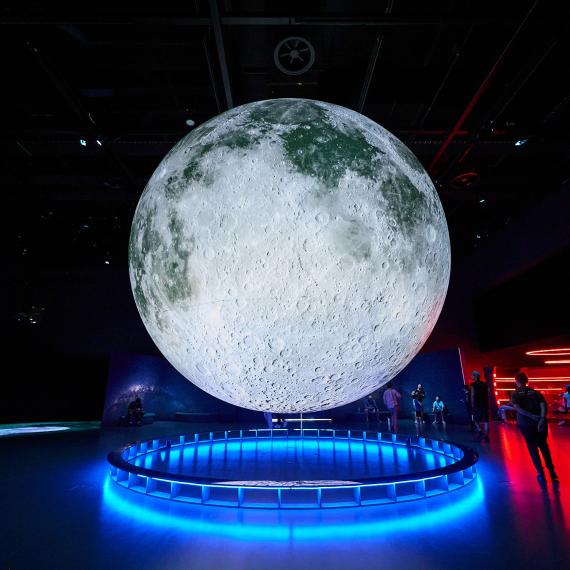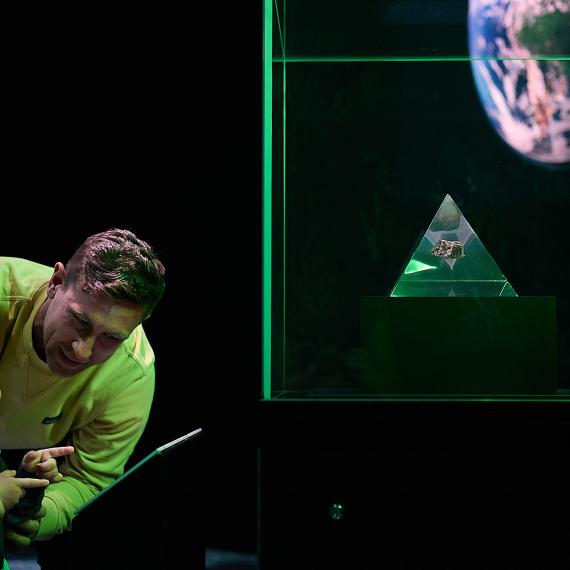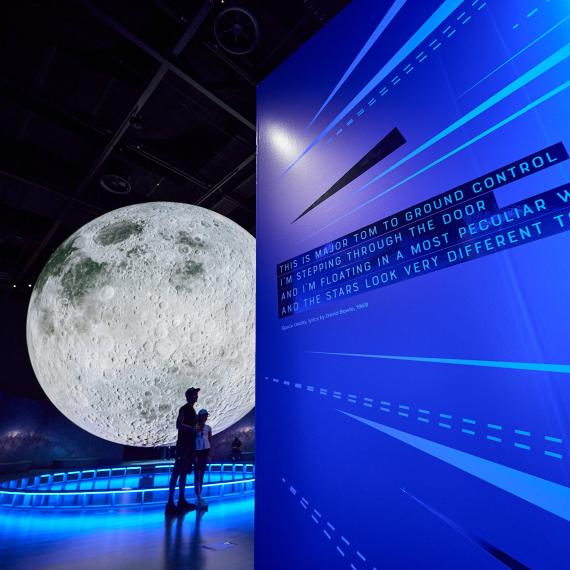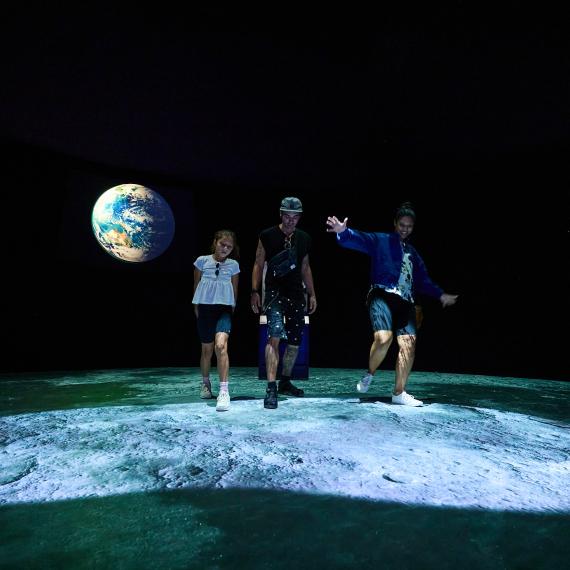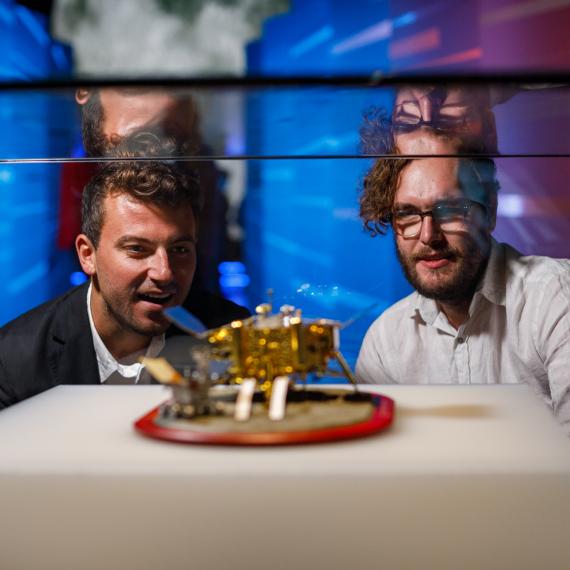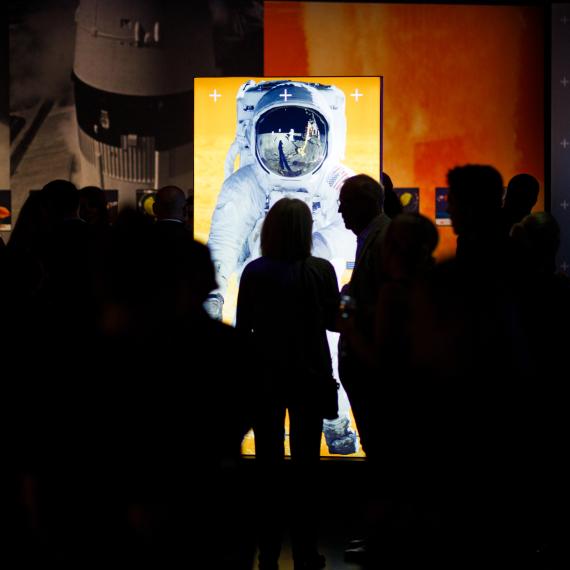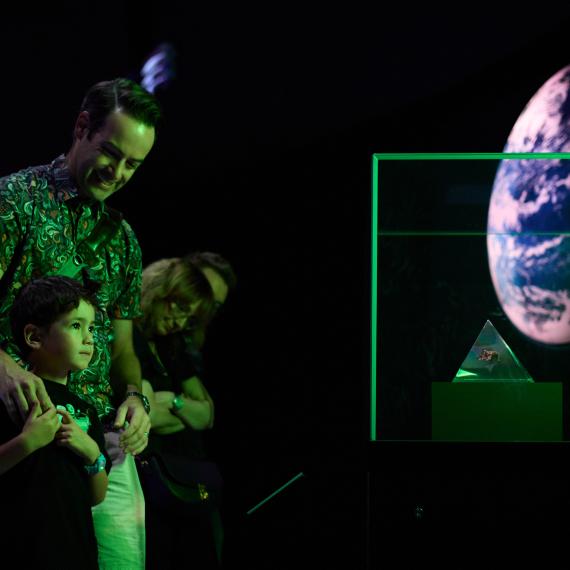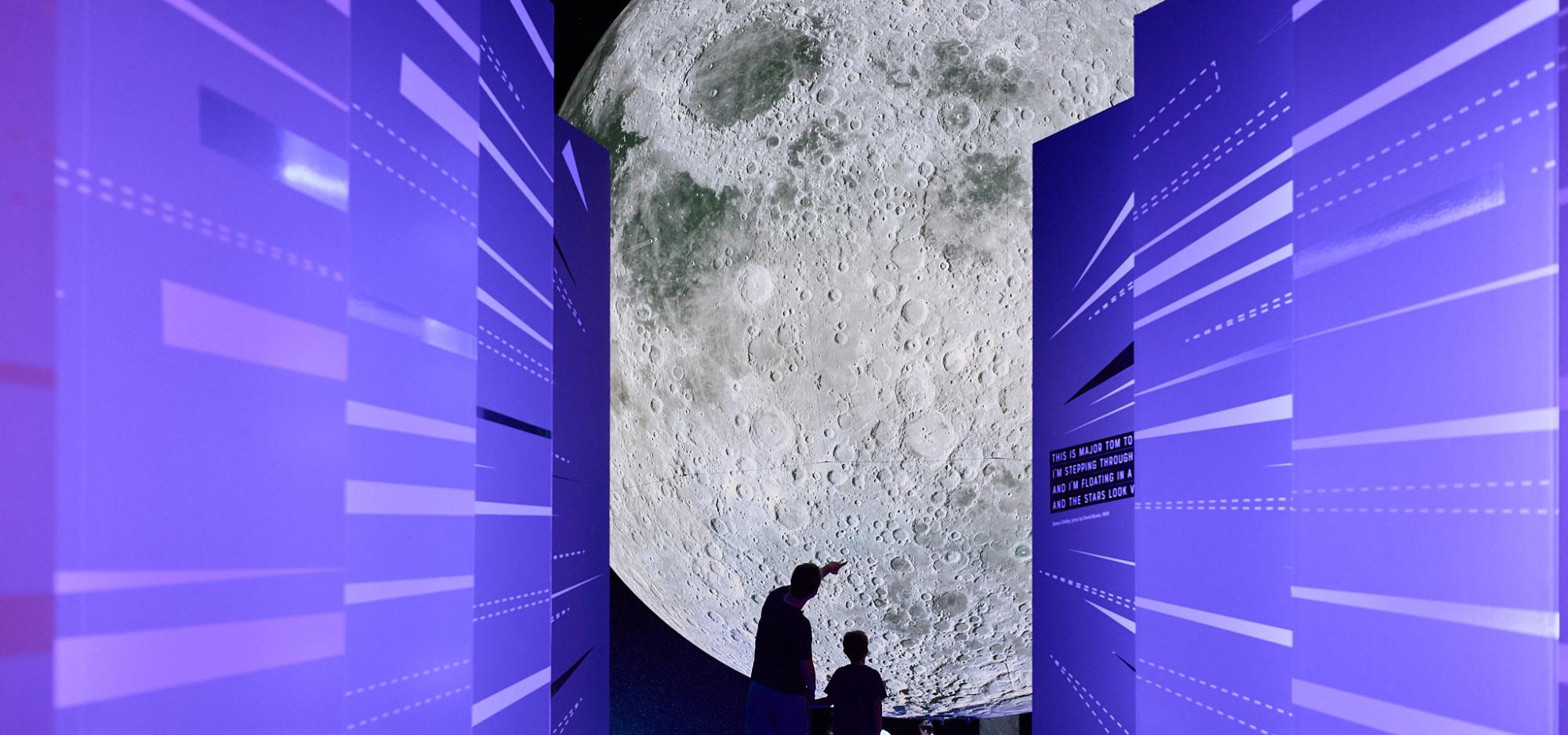
Origins of the Moon with Professor Katarina Miljkovic
The origin of the Moon was a mystery until Apollo astronauts brought back samples revealing that the Moon and the Earth are essentially made from the same stuff. The conclusion was that the Moon had to have come from the Earth! The leading theory suggests that a giant planetesimal struck the Earth during its early geological formation and ejected material that seeded the Moon. In this lecture, Professor Katarina Miljkovic explores the impact origin of the Moon.
-
Episode transcript
Introduction:
You're listening to the Western Australian Museum Boola Bardip talks archive. The Western Australian Museum Boola Bardip hosts a series of thought provoking talks and conversations tackling big issues, questions and ideas.
The talks archive is recorded on Whadjuk Nyoongar Boodjar. The Western Australian Museum acknowledges and respects the traditional owners of their ancestral lands, waters and skies.
Hello everyone and welcome to Luna Lounge. before we begin, I'd like to, pay, acknowledge the Whadjuk Nyoongar on who’s lands we learn and meet today and pay respects to elders, past and present. This evening we are joined by Katerina Milkovich, who over the next 30 minutes is going to be taking us through the origins of the moon.
Welcome, professor Katerina.
Katarina Miljkovic:
Thank you, Zoe, and good evening, everybody. I also extend my acknowledgments to the people which the land we walk today and pay my respects to the elders, past, present and emerging. I was very impressed with all the beautiful artwork that you can see from different peoples of this land as you were walking into the through the gallery. it really blows me away.
So I work as an associate professor in planetary science at Curtin University, and today, I speak with you as a planetary scientist about the origin of the moon. It is a great place to talk about the moon dare I say, It’s quite a unique setting to, kind of like a visual pun, almost, talk about the moon under the moon? I promise it's not that big in nature, but I will run you through a few fun facts before we start talking about its origins. So if you were to project Australia onto the surface of the moon, it kind of fits like this. But if you look at the width of Australia, it's maybe this wide this point around 4000km.
Well, it's just a little bit bigger than how wide is the moon. It's about 300, 2500km. So when you really think about the actual size of the Moon, it's not that. It's about the size of a continent, in terms of its, its diameter. And, in terms of where it is, it's just under 400,000km away and about takes about three days together with a rocket of present day.
And here it is a little bit of astronomy. It is a very important part of our story about origins of the moon. For those astronomers, enthusiasts, let me run you through some orbital dynamics. We have our Earth, and our Earth spins around its axis. It's got the equator. That equator is tilted compared to the plain through which the Earth is moving around the sun.
That's called the ecliptic, but it's tilted by about 23 degrees. If we look at our Moon, our Moon also spins around its axis, and it has a slight tilt compared to, to the Earth's equator. But when you look at the moon's rotation axis compared to the ecliptic, it's perpendicular. And that's the first issue in dynamic in the dynamics of, planetary systems Is that why doesn't the moon have an orbit that is really within the Earth's equator? It's not within the equatorial plan. It's in within the ecliptic plane. And that's the first dynamical problem that we face in trying to discern the origin of the moon problem. The other thing that we can look into before we start thinking about theories is the internal structure of the moon and the Earth.
What we know from research is that the moon is iron poor, so to say, and that kind of fits with this explanation that the moon's core is very small compared, relatively, compared to the Earth's. Earth's core is substantially bigger, relative speaking, than the Moon's, and that accounts for the bulk density of our planet. The bulk density of our planet is almost double than what it is on the moon.
So if you think about this stories about the the origin of the moon, that's a really big science factor that we have to consider. So before the Apollo program, and I would like to emphasize the Apollo significance under the, under the banner of, of everything that we've got from the Apollo program in a paradigm for 50 years ago.
And before the Apollo program, there were, let's say, four ongoing theories. Hypotheses, not even theories, hypotheses as to how moon came to be around the Earth.
First one, the top left would be capture, which means there was a an asteroid flying by, and the Earth's gravity captured it into a stable orbit around itself. Dynamically speaking, that's unlikely. It's statistically unlikely to capture an object free flying in a solar system into a stable orbit.
We do have many moons and objects that planets can temporarily capturing in their orbits, but then they would become unstable again and they would leave. So explaining that for the moon doesn't really work, and particularly because Moon is nicely shaped, round, kind of planet like body. But if it was a captured asteroid, it probably would have been banged up and quite irregular. That's another problem. And also it doesn't go around the equator. It goes around the ecliptic. That's another problem. Then there is a story around fission , meaning we have a young, very young, strata Earth planetesimal about to form the Earth. And it's spinning so fast or spinning in such a way that a bit of mass splits. I don't think anybody buys that, really, but it's very hard to explain.
It's in the books, so let's mention it. Again the problem is Moon doesn't go around the Earth in equatorial plane to support the fission theory. Then we have the binary accretion. That means the Earth and the moon formed at the same time from this disk of gas and dust, or some kind of dusty disk. Then all of a sudden we got this, kind of moon body there, kind of at the same time, not too far off truth but then the question is, how did I come to that point?
And then we have the theory or hypotheses about a collision that a body of the size of Mars could have struck Earth at some point in its history, and then that created a collision, quite a violent one disk of debris around the Earth, and from which it was seeded the Moon.
Spoiler alert this is the leading theory that we're going to talk about today, but with a little bit more finesse than just that cartoon. Okay, so we can fast forward, maybe tens if not hundreds of years after of people thinking about where did the moon really come from… And we have been over 50 years ago we had this amazing Apollo program, and I'm looking forward to the day when human walks on the moon again, hopefully with Artemis program, maybe in our generation, in our lifetimes, because I wasn’t born when the Apollo program was happening, and I feel a bit sad that I missed out on Apollo and Pink Floyd but, you know, maybe I'm still happy that I'm, you know, relatively young.
So what we have here in front of us is one of the Apollo missions, Apollo 17 mission, the one that had a buggy. One of the one of the buggies there. They had this privilege to drive around a little buggy around the moon and poke at rocks and collect rocks and then bring them back home.
So they did not bring this entire boulder, although I think planetary community would have died to have a rock that size in their lives. So they were collecting samples from different regions on the moon, and they brought it back to the Earth for laboratory analysis, one of them being that one there in the corner. If you're wondering where the landing sites were so you have, the Apollo landing sites in Blue… we had, six Apollo missions, brought back samples back to the Earth in the late 60s, early 70s. We also had three Russian missions that were robotic. They brought back some samples.
And although by having humans on the moon with those six missions, they brought back over 100, 200 kilos of soil surface soil from the Moon the robotic missions, they all together, three missions, lunar missions from Russians, brought back about a bit over a kilo. And then we have the Chang'e five mission, which is that Chinese mission that brought back samples. a lot, lot less than these, obviously, but it was one of the recent missions, and there are new missions being planned to bring more samples from the moon, from the Chinese and as well as I think, Russians, possibly and also Artemis program plans to put man or woman… human back on the moon. So when we look in hindsight, there is a myriad of information that were brought back in those couple of hundred kilos of soil samples from the moon that we are yet to analyse. Trust me, there are still canisters of lunar soil that haven't been opened and analysed, so they kind of look a little bit like that.
They're very, very different. They're very weird in some way. They don't really look much earth like one of them being in the corner but generally there is broken up crustal rock that has been banged up by impact. And you can see all the craters right there behind you as you're walking around the moon. There are millions of craters on the moon that we have kind of counted so far.
And because the Earth and the moon are in the same planetary system, then you would have think, oh, hang on a minute, if the moon had been bashed so much by impacts, wasn't Earth as well. And the logical answer is yes, it definitely has been bashed by impacts. But Earth is a dynamic planet. It's covered by oceans. Two thirds of its surface are oceans. It's got tectonics, volcanism, it's got wind. It's got sand everywhere. So the surface of the Earth, the one that's not covered by water, it's still relatively young, geologically speaking. So that surface does not preserve any of those big impacts that could have happened if it had happened on the Moon. So the Moon is our actual laboratory for understanding the very early evolution of the solar system, because we can't do it on the Earth and the big value comes from this sample.
So I'm going to dare to say in something around 20 odd years ago and the dates would change because the techniques improve over time. But one of the biggest smoking guns in theories in in explaining this area of the moon was, the investigation of stable isotopes from the samples that were brought back from the Moon, particularly oxygen.
So for those who need to brush up on your chemistry, the isotopes are those atoms that have different numbers of neutrons in them. So oxygen 1617, 18 same number protons and electrons, but different numbers of neutrons. And they're called stable because they do not break down over time. So what you see is what you get. That is the original composition of the solar system that has been preserved over time.
We also have, those radioactive isotopes that probably a bit more familiar. We also have those in samples measured that then give us an information of absolute age of those rocks. But let's go back to oxygen. So oxygen is very, very important because when scientists measured the amount of, different isotopes of isotopic, isotope, oxygen isotopes in the samples specifically what they look for is they measure, fractionation.
So the ratio between different oxygen isotopes and what we get in the end is some fancy diagram. It probably looks a bit more complicated than this one, but what was really a smoking gun here is that when we look at ratios of different isotopes, oxygen isotopes in lunar rocks, the data is smack on identical to the Earth's. So the line, the straight line you see on the plot is so-called the, Earth fractionation line and they come from the oxygen isotopes that are found in Earth rocks. And so it happen that it's the same on the Moon. And that was the smoking gun that came out of the Apollo rocks that told us that the Earth and the Moon had to have come from the same stuff. They had to be born at the same time from the same stuff in the solar system.
If you for example, look at, Mars, which is a little bit above line, or Vesta, the largest asteroid just underneath the line, that doesn't that doesn't mean the only means that formed in different regions in the solar system. It doesn't tell anything about the age. It tells you about the composition, the location, how far they are from the sun when they were formed.
So now we can say we prefer that our leading theory is that they had form at the same time. So no capture no, fission probably… this is probably unlikely, but they do come from this kind of collision of elements. So this is a simulation of the somewhat simplified of how a young star forms a planetary disk. First we have a young star in a disk of gas and dust swirling around the young star.
And as the star matures, he blows away that disk of gas. And what's left behind are all the planetesimals. But what has been happening with the dust at the same time is first clumping into dust bunnies and dust bunnies in the big dust bunnies, and then become sticky collisions and then bigger collisions when things break up and eventually you end up with the planets, with the asteroid belt and occasional rogue rocks here and there.
And in that period is when we'd expect that the moon had formed. In fact, we know from unstable isotopes, from radio radioactive isotopes, we know the actual age of these rocks. And they tell us that moon should have formed at least 50 million years after the solar system formation. So somewhere in this process.
And then the further to that theory people have made, scientists have made fancy, dare I say, simulations of impact origin, and this is the one that's very recent from NASA and from Durham University showing, what this long believed that a Mars size body struck proto Earth.
So we know that we needed to have not a planetesimal size Earth, that we needed something that's starting to become a planet because it waited these tens of millions of years during formation of the solar system before it got struck by a large body. And we believe that large bodies and size of Mars, because that kind of law fits with these collisional simulations.
So I'll show you how that looks like. So if I can find my mouse. There we go.
So this is, so-called smooth particle hydrodynamic simulation that, shows Theia, that kind of large mass size planetesimal that struck the Earth. It leaves complete havoc behind, but it also throws away material into its disk around it in kind of some really weird, unstable orbit around it. It creates a disk. And what you see here is just rocks flying everywhere, molten, fractured, flying everywhere and out of that disk was seeded the moon. And it kind of goes on for a little bit longer. And then we get our, get our moon. Somewhere there, like a little bean. Like a little seed. Okay. What is really curious and interesting about this particular um setup, remember when I said at the beginning that that moon is iron pole? That means if you had a really big head on collision when two big bodies smashed together, chances are you would have also engaged cause, though the cause of those planetesimals would have also mixed together because collisions are quite violent, very high energy events that, you kind of can't, just can't, can't prevent it. But if, if the impactor planet, Theia, wasn't super big, so then hence the Mars size and it hits under kind of a grazing angle or like an oblique angle.
So it's kind of sideways you might accuse me of, like you're now you're just cherry picking the best scenario. But it's true. Statistically speaking, no impacts really happen head on. They all happen like weird angles. And in that collision, what's happening is that the, Theia gets entirely destroyed, including if it had been differentiated into a core at all, but the proto Earth's core stays relatively preserved. So what you're throwing out into the disk around the new Earth is something that's made out of the impactor material and a little bit in the crust and the mantle of the Earth. You're leaving Earth's core behind, which is possibly one of the reasons why Earth has a bigger core and it's more iron rich than the Moon. So that means Earth and the moon are twins. They're born at the same time, but they're fraternal twins. They're not. They're made of the same stuff on the on the outer layers, but not in taught in an entire DNA. So that explains the difference in bulk densities as well.
And here is an even fancier simulation for you, made by my colleague over in the US. And her team. You're getting a similar scenario where Theia, Mars sized body strikes proto Earth… but in this simulation, not only did it includes that debris of solid materials, It also includes a lot of melt and vapor that's blown into space.
So it becomes very opaque, that disk of now gas and dust that swirls around the impacted Earth and it forms kind of a Taurus donut looking disk that is beginning very opaque because it includes very high pressure gas, very much molten material, vaporized material...the droplets are forming of the molten rock. And as the disk actually cools, it forms first. The vapor condenses, is droplets, and droplets start to cool and coalesce into solid fragments and that's how you end up with that disk of debris that is further colliding and seeds the moon.
So that is probably one of the most sophisticated simulations I have actually come across and that's the that disk is, named Synestia because it looks a little bit like a donut, but it kind of flattens towards the middle and it doesn't have a hole.
And out of that disk is then seeded the moon. So when all of that gas is blown away and things get bit more steadier, maybe within a matter of days, even, what's left behind is new Earth and the Moon. They're covered in magma. So this is an artistic interpretation, obviously, but as everything else I've shown you. But the Moon is suspected to have been covered by the global magma ocean, so it's entirely magma ball not to its core, but along its surface. To about 100 to 500 kilometre depth, according to some modelers. But also the Earth was left as a magma bowl. Might not have been a global magma ocean, but it's certainly been quite hot and quite heavily bashed and destroyed by this process. But we're not talking about Earth, we're talking about the moon.
So what's happened to the moon then? What is believed is, from the dynamics point of view, that the, this kind of hot new moon is formed relatively close to the Earth compared to present day. So not at 400,000km quite closer to the Earth. They might have assisted with its tidal locking. We don't know. We don't even know when the moon got tidally locked to the Earth.
But it is believe that it's formed relatively close to the Earth. And then over time, it had migrated. So I don't have to go through the details of this particular dynamic simulation. But let's see this way. So Moon had formed close to the Earth, and then it started to move away slowly to the present day, present day we’re at 400,000km, but the Moon is still moving away from us at the same rate as our fingernails are growing.
Eventually we will lose the Moon just by it's moving away. We know that because the Apollo astronauts have left laser reflectors on the surface of the Moon, so we can shoot lasers at, at its, and to the Moon and back and get the exact positioning of the Moon. And now we know that it's moving away.
But dynamitists is looking at this early, evolution of the solar system and looking at the, formation of the moon process have also suggested that not only that, it was close and close to the Earth, but it could have also had quite an erratic, orbit, which can partly explain why it also sits in the ecliptic, notin the equatorial plane, but also it explains the way it had been geophysical evolved. So if it had this weird orbit that it goes up and down, back to front, changes in eccentricity or inclination of its orbit, which is what can be justified by numerical modelling, that would, that would explain, for its present day orbit. It would also explain how it physically evolved over time, because the tidal forces of the Earth and the Sun has also been affecting the way the moon it formed into the planet, into the planetary body that we see today.
But this is not the end of the story. I want to tell you a few more things. And, I already spoke about that and won’t bore you with numbers. So we now have this very young Moon somewhat, maybe erratic, maybe not orbit and that orbit didn't settle for 52, maybe 200 million years after moon formation. What is very interesting is that in the very early history of the solar system, let's say the first 700 million years after Moon formation, we have evidence on that globe that both Earth and the Moon have been bashed by massive impactors, but not those that are planet shattering, but those that are crater forming. So if you look at any of the as you're going around the globe, you'll probably see some of these really big circles and some of those big circles are easily spotted like that one there. That's the youngest impact basin on the moon, about 3.7 billion years old. It's called Orientale. Published two papers on it. So I know by heart in science. But if you look in the near side of the moon, you can see all the marrow regions, all the darker regions. They're called marrow because they're compositionally different, they're basaltic, and they are not made by impacts. They're made by volcanic eruptions. But they sit in these basins, in these depressions where the crust of the moon is thinnest so that magma could have erupted there, over a long periods of time at that time. But these big, basic big basins are also made by giant impacts. Not Moon shattering, just crater forming.
Let's say the biggest impact, the biggest impact on the Moon was made by a rock that's 200km across. It's pretty big, I would say. And then that one is made by rock, was 50km across. They made these big craters at 1000km across. They completely changed the structure of lunar crust and the way the whole Moon was actually physically forming.
But those big impacts only happened during the first 700 or so million years since solar system formation. And we know that because of the exact, absolute radiogenic ages of rocks that we brought back from the Moon, because we don't have rocks that age on the Earth, we have some of the minerals that we can find it as old as the solar system, but not the actual rocks.
So that is our laboratory for the early Earth as well. But we know that this impact flux, so-called. So frequency of these impacts as it happened in the solar system, it decayed over time. So first 700 million years or so, it was kind of drastic. These big impacts happening here and there. Moon had preserved them in the geological record, Earth didn't. But there is nothing to tell us that it didn't happen. It's just that we can no longer find it on Earth. And then things stabilized. So that's how we ended up having all of these big scars saved on the Moon. Because thanks to the Moon being dynamically dead, well, not very much active, we have, It's just been sitting there and collected impacts of prolonged of long periods of time.
And just for the fun of it, I'll, I'll keep going for a little bit longer. I'll show you some different maps of the Moon. So the one on the top is a thorium map of the Moon… near side and the left far side on the right. And apologies on all the maps, north is up, which is exactly the opposite of how we Australians see the Moon. When we walk out in the backyard and see a full moon, right? We actually stand on our heads and our Moon is upside down. So that is not accurate. But let, let's, let it slide. I did complain and they said that we can’t hang it upside down. You know. But anyway if in textbooks this is what you will see.
So, you know, fair point. That's how we see it here. An on this side of the Moon there is and actually, we have heaps of maps in different, made by different, instruments and different orbiters. So the one on the top is the one that's showing you a thorium map, so these are all radioactive. The thorium is very radioactive but it's also a heat producing element because it's radioactive.
So what we believe is that during a very early moon cooling phase, when it was cooling its magma ocean and being so close to the Earth, and kind of in this kind of funky, dynamic state that something somehow the… as it was starting to cool and differentiating to core, mantle and crust, some of that heat producing elements got focused in some way through convection, possibly into that near side that it was facing us where the crust is the thinnest.
And that probably have caused… sorry… caused that all the volcanic eruptions to have caused on that near side of the Moon. On the face of the Moon that we see So the moon that we see when we look up at the sky, we don't have a lot of volcanic eruptions on the other side of the Moon. And if you walk around the globe, you'll see only the dark regions on the near side, not on the far side.
So it looks a little bit boring, doesn't have all these big impacts, doesn't have any Mariners, very few spots. So the bottom map is actually showing you the outline of where the volcanic regions are. Those are all the dark patches that you see on the surface. But the volcanism on the moon stopped at about 2 billion years ago.
So it did happen, long after the big impacts had ceased but it had still been active for a while and then it stopped. And since then it’s just been sitting there and collecting, collecting impacts and impact craters, as we see on the globe. And then, I'm going to skip to that one because I'll show you something else.
So do you want to see how the big, big craters form? This is something that we love to do at Curtain. Let me see. Okay, so that's a 60 kilometre asteroid hitting the Moon. But on the left hand side is what it would have the formed, the crater on the far side of the moon. And if you look on the right hand plot, that one shows if it had formed on a near side where Moon had all these thorium deposits, it was warm and had all this volcanism happening.
So we can also measure the kind of bombardment Moon experienced and understand that it had a quite an asymmetric thermal evolution as well. That near side of the moon was warmer, was hotter for a longer period of time. It also had thinner crust so here's another funky set of colours. The bottom plot here shows you near side of the moon on the left and the far side on the on the right, and all the blue regions are very thin crust. And then it goes to the middle crust around this yellow is greenish regions and it goes into red and white where is the thickest crust. So we know that the near side of the moon facing us actually has quite a thin crust. That's where all the volcanism happened at some point. So we know awful lot about a moon that started with the Apollo, era and then kept on going with subsequent missions. But that's a story for another lecture, so stay tuned and come back in the next time.
What I'm going to leave you with is, another map of the Moon with a projection app like that one. but I'm outlining here the largest impact craters on the globe. And these all had formed in the first 700 million years of the moon, and they're all made by massive asteroidal objects that have bashed the moon, during that period. We don't have records of that on the Earth, but by studying the Moon, we can certainly consider that it should have happened on Earth as well and help shape kind of our understanding of our own origins during very early Earth. So I'm going to stop there. And now I'll open the floor for questions, if you like. Thank you so much for your attention.
Audience:
What would have happened if an asteroid struck our ocean?
KM:
Depends on the size of the asteroid. Anything. If it's a small asteroid, probably a local tsunami. Probably would affect our climate a bit, because a lot of the vapor would go into the atmosphere. If it's a bigger asteroid, it would be a bigger tsunami. And then we'd have a lot of atmospheric effects, and then atmosphere would have probably harmed the entire changes in the atmosphere, and a climate would harm the rest of the planet.
That's, in fact what happened to dinosaurs. So 65 odd million years ago, a planetary body size that was about 14, 15km across. So it would have made up not a big crater on the Moon, but, you know, less than a basin size. But it hit the Gulf of Mexico. That was probably in shallow water or maybe still land kind of half, half. And, so how did an impact of that size that created a crater that's about 200km across would have actually caused a global extinction? You know, the answer is not that all dinosaurs happened to live in the Gulf of Mexico at a time. The answer is, is that whatever got like, regionally affected by, by the debris, by the heat produced… sure it goes, It's getting eradicated, but what happened is that in, in the in immense amount of gas and dust was blown into the atmosphere and then atmosphere carried it through the entire globe. And by having so much dust in the atmosphere, the whole sky darkened. And that permanent darkness lasted long enough to cease further synthesis. That stopped having plants growing. The dinosaurs couldn't eat and, you know, chain reaction occurs and which is why we now have lost most non-avian dinosaurs. And I guess it's a good thing for us because we made way for humans, but bad for dinosaurs. And that happened about 60… That happened 65 million years ago. But the impact of that size in terms of frequency of impacts happens about once in 100 million years. So we can breathe easy for another 40.
Audience (Question not recorded via mic)
KM:
Okay, so the question was around the samples. And because they do have the same oxygen isotopic fractionation, how did actually vary in terms of composition. And so most of the samples were from Apollo were collected from the near side from this kind of region where the basaltic areas are. So that constrains a little bit of diversity in chemistry. They're all similar. They're all come from this bracketed, broken up soil, rock. There could be basaltic be more crustal. Some samples are pegged to have come from the mantle, because of their variation in compositions. So we but it's regionally constrained to probably that front near side of the moon.
Audience (Question not recorded via mic)
KM:
Got it. So the question was like, why moon isn't as protective as the Earth? So on the Earth we've got the atmosphere and we have the magnetic field. So that shields the surface of the Earth from nasties like nasty radiation and also, rocks from space because you surely have seen a fireball in the sky, right? So those rocks on the moon hit surface and make a little crater because there's nothing to oblate and drag them through the atmosphere because obviously doesn't exist.
Why doesn't does it not have the atmosphere? It's a small body. And if it ever had some kind of gaseous cloud around it, it's probably lost it because it's tiny. It could have something to do with the way it was formed, but most likely because it's small and it's also believed that moon had a magnetic field.
It had a, probably a dynamo. So same as the Earth that got switched off during the first... I don't know how many billion years. That’s still for us to find out.
A lot of the research is done in looking at magnetization of Apollo rocks and checking that back to the ancient magnetic field of the moon. So we think that the moon had a magnetic field that because it's so geologically, I was going to say boring, but, because it's small and because it's cooling, the smaller the planet, the fast it cools, then it will actually start switching off some of those mechanisms that are still alive in our planet.
Complicated question. Short answer.
Audience (Question not recorded via mic)
KM:
Yes. So the question was, once the Mars size object hits the Earth, how long does it take for the to. to form the Earth and the Moon? Short answer is, I'm not sure, but in geologic scales, quickly. So we're not talking millions of years. So that celestial object that forms within a matter of days. So the this kind of violent process of impact events, they, they're geologically very short, so they can actually happen, incur and finish within a matter of days and then all that condensation and happens quickly but then all the clustering of the dust might take a little bit longer, but not millions of years. We're talking stuff that it's hard for us to discern in geological scales.
Audience (Question not recorded via mic)
KM:
What is the best public observatory in Australia? In what domain? (audience answers)
To look at the moon? Buy telescope in your backyard. For the moon for sure. I don't know. Try Perth Observatory. They have probably, um, tours and they have ‘observed the moon’ days or something. if not, I'll suggest. But, moon is really big. The reason I'm saying your backyard in an amateur telescope is that the Moon is really big, and it's unforgiving because it reflects also a lot of sunlight.
So if you're if you're looking, you know, to a fancy telescope, it, it doesn't fit, you know, like your, your big telescopes are made to look at distant objects like point sources nebulas and galaxies and observe the so far away. But anything in the solar system is kind of unforgiving because it's too bright. So you would want you want a telescope so it fits the whole Moon or maybe part of the Moon and for that, you can do it with any amateur telescope, really, just to look at these kinds of features.
(Audience comment not captured on mic)
KM:
So then you would go for more serious observatories, you know. Have a look at what James Webb Space Telescope has become and returning back as the next generation of the Hubble.
So that's amazing.
For that, you know it’s not in Australia kind of be there for the time to like ‘can you please point that?’, you know, it's, it's, it's in it's in the solar system itself flying. So you it's, it's in it's everybody's I don't know in Australia though.
(Audience comment not captured on mic)
KM:
I’ll come talk to you after. The question was about tidal forces. The point is, is that the moon the moon is tilted towards the Earth, and the Earth isn't perfectly round. It's kind of got bulges on its equator. So where as it's going around the Earth, the kind of, the gravitational force between the Earth and the moon isn’t equal everywhere. And also it's harder for the gravity to pull on the rock, but it's easier to for it to pull on the, on the water, on the water and something that's soft. That's how you end up getting a tug and pull.
All right. I think they’re going to boo me off the stage soon. Thank you very much for your time tonight I appreciate it. Thank you.
Boola Bardip Outro:
Thanks for listening to The Talks Archive brought to you by the Western Australian Museum, Boola Bardip.
To listen to other episodes go to visit.museum.wa.gov.au/episodes/conversation where you can hear a range of talks and conversations. The talks archive is recorded on Whadjuk Nyoongar Boojar.
The Western Australian Museum acknowledges and respects the traditional owners of their ancestral lands, waters and skies.
More Episodes
Writer, puppeteer, and folklorist Clare Testoni tells the story of the Moon's many faces in folk and fairy tales around the world.
Join Dr Natasha Hurley-Walker, ARC Future Fellow at Curtin University, as they explain how lunar radio waves let us explore the universe.
Join the stellar Sandra E Connelly and Dr Phil Bland in the To the Moon exhibition for a fascinating conversation about NASA's seven-billion-dollar mission to explore Earth, the Sun and beyond!
Join Richard Tonello as they discuss and debunk all things lunar conspiracy, from the flapping flag to flat earth theories, missing stars and the moon's reflectivity index.
Explore the realm of off-earth habitation and hear how plants can be engineered for space exploration and altered Earth climates.
A conversation between Dr Chantal Bourgault Du Coudray & Lucy Peach, discussing the cultural significance of the moon and how this relates to women.
Join Professor Steven Tingay to discover how the moon itself is a telescope for radio astronomers.
Join Professor Eric Howell in this talk that delves into the heart of multi-messenger astronomy, highlighting its potential to decipher the intricate mechanisms driving these cosmic phenomena.
Join Dr Robin Cook on a celestial journey exploring the mesmerising interplay of the Sun, Moon, and Earth
In this talk Professor Bland outlines the mission that Curtin is developing to find ice on the Moon in accessible locations.
Join Xavier de Kestelier, Principal and Head of Design at Hassell, to hear about Hassell’s design journey and collaboration with the European Space Agency to develop a innovative concept for a thriving settlement on the lunar surface.
Join Dr Benjamin Kaebe, an engineer, researcher and teacher, as he discusses the opportunities of a Western Australian space economy.
Professor Phil Bland provided an overview of Artemis, and what the next decade of space exploration might look like.
